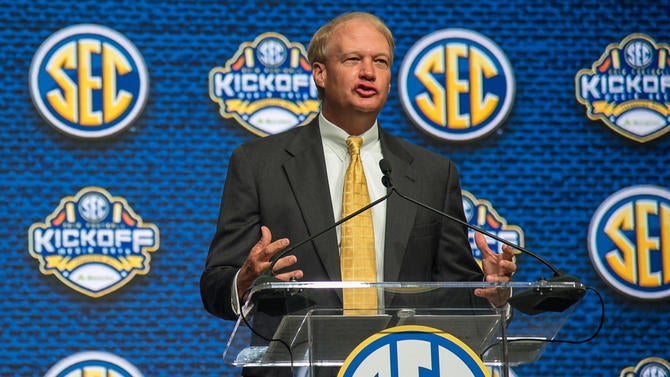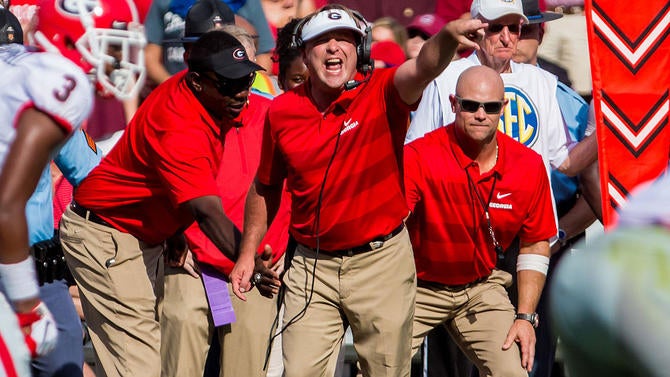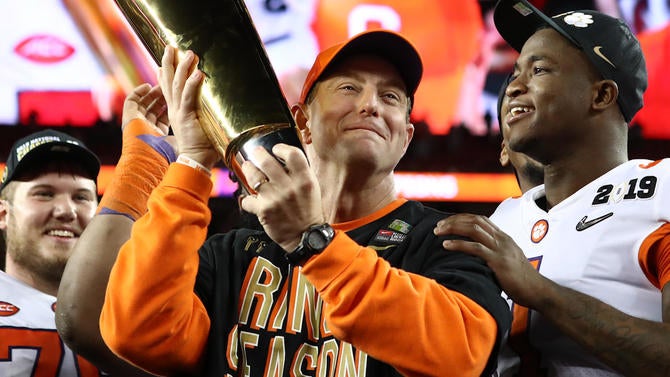Facing a roomful of American Athletic Conference coaches and administrators this spring, Steve Hatchell made another defense of the sport he loves. In some form or another, Hatchell has spread the NFF mantra of “Football Matters” as far and wide as he can.
Those two words carry extra weight these days. Football matters more than ever. Hatchell calls his crusade a “campaign of positivity,” though the entire discussion reflects what has become a battle for the future of the game.
In this decade, the viability of college football has come into question. For a game that is as part of the American psyche as apple pie and Chevrolet, the ongoing deliberation has caused folks to choose sides and college football to become introspective as it looks to address its own flaws.
“Football requires you, on the down-by-down basis, to willingly deny your basic human instinct to seek pleasure and avoid pain,” said Aaron Taylor, a two-time All-American at Notre Dame, six-year NFL veteran and Super Bowl champion who now is an analyst on CBS Sports Network.
“When I’m walking down the street in New York City and somebody jumps from behind a building, your natural instinct is to duck or shrink away or protect your head,” he added. “It’s the opposite in football. We lean into it. We seek contact. You look for it. … In that process, I think we learn things about ourselves … that we wouldn’t have an opportunity to learn any other way. That’s the basis of me never wanting to see this game go away.”
That’s what makes the game so complicated to digest these days.
Heading into its 150th season, college football — really, football as a whole — isn’t going away anytime soon. But it has certainly been altered. Judging by the litigation surrounding the game, some traditionalists believe it is losing its foundational principals. Whether it is new rules regulating contact or limits on the defense’s ability to impact a game, things are changing. All this while debate continues over player safety, plunging participation numbers, player compensation and even attendance.
“These are modern-day gladiators,” said Ryan Felker, former coach at Mesa Community College whose program was eliminated last year. “Football is under attack. It’s not going to come from a junior college guy like me, stomping my feet saying, ‘It’s unfair to our community.’ It’s going to have to come from a higher level.”
Change is ongoing
Steve Shaw is a different kind of passionate advocate for the game. He is also one of the most powerful men in college football whether the affable NCAA secretary-rules editor likes it or not.
Shaw is an Alabama graduate with a degree in mathematics and a former referee who has risen to become the SEC supervisor of officials. He is steering the national rules discussion toward increased safety. Shaw has spoken widely in the offseason on the importance of the new targeting rule as well as ridding the game of the final remnants of the wedge on kickoffs. His big picture vision of the sport’s future recently was significant.
“If you go back to the 1950s, what were the top sports in America?” Shaw asked a group of officials and media in April.
When the answer came back as horse racing, boxing and baseball, Shaw responded, “Where’s boxing today? If we don’t make changes for the good in our game, we could lose our game.”
In just the last few years, the NFL and conferences have reduced full-contact practices. That much-discussed targeting rule — that has been around since 2006 — has definitely changed behavior. Whether it’s the threat of litigation or genuine concern (or both), the game is changing before our eyes.
“I don’t think there is a question about football getting safer,” said Dr. Javier Cardenas, a noted Phoenix-based neurologist specializing in concussions and brain injuries. “There are policies for practice at all levels — high school, college and pro — to have fewer contact practices. If you’re limiting contact in practice, you’re limiting head impact.”
Simple as that? Hardly. Taylor has seen six close football-playing friends commit suicide. Whether the rigors of football played a role in their respective deaths is not known.
“When we retire, we go through an identity crisis,” Taylor said. “We lose our significance; we lose our identity. Whether we had concussions or not … there is a cycle of grieving we go through regardless. If you lay on top of that high levels of divorce, the high levels of bankruptcy, the high levels of drug and alcohol addiction, now you’ve got yourself a gumbo of some pretty gnarly shit.”
“Personally, no, I don’t think football safe,” said Linda Shoemaker, a University of Colorado trustee. Shoemaker made her views known nationally when she voted not to approve the contract of new Colorado coach Mel Tucker. Her reasoning: Tucker said in his introductory press that his dad had taught him the name of the game is “hit, hit, H-I-T.”
This year, blind-side blocks in college will be penalized. They will have to be replaced by the so-called “spray-paint” block — similar to a screen in basketball. If players don’t abide, the age-old “decleater” is now a personal foul.

This is not a new conversation
This season, the last vestiges of the flying wedge are becoming extinct. The NCAA rules committee has banned two-man wedges on kickoffs. In that sense, it has taken 114 years to wipe out what preceded then-President Teddy Roosevelt’s involvement in a football safety summit at the beginning of the 20th century.
That summit was called after 19 college football deaths alone in 1905. Out of that meeting, the NCAA eventually evolved.
Those health concerns haven’t subsided. The elimination of football at Arizona junior colleges last year drew rebukes from of college coaches all over the country. Officials in Arizona cited increased insurance and upkeep costs.
“They gave it up because they couldn’t afford it,” said David Calloway, who has recruited Arizona as coach at Central Methodist, a small NAIA program in Missouri. “Insurance is killing this game. That’s going to take a toll.”
The boundary lines for this debate were basically drawn — or at least made clearer — when former North Carolina coach Larry Fedora said last summer that the game was “under attack.” He added that changes to football could be “the decline of our country.”
At the time, decreasing youth participation nationwide was already an issue. High school football participation is down three percent over the last five years, according to the National Federation of State High School Associations.
Since the federation’s peak in 2009-10, participation is down 6.5 percent. Participation in California high school football is at a 20-year low, down 12 percent in the last five years.
Just don’t tell that to anyone in the Deep South, where the game continues to thrive.
“Is it scary?” Georgia coach Kirby Smart said of the declining participation numbers. “It’s very concerning, but I don’t know if there is a lot we can do about it. High school football in Georgia, I felt it’s really been good for a long, long time.”

A changing landscape
Perhaps this is another example of all politics being local — even in football. The game continues to centered in the Southeast and, to a lesser extent, the Midwest.
The SEC’s current grip on the game started in 2003 with LSU’s national championship and hasn’t been loosened. That despite Clemson (another power from the Southeast) winning two of the last three national championships.
“Who knows, they may do away with college football in three years,” Clemson coach Dabo Swinney said earlier this year. “There may be no college football. They may want to professionalize college athletics. Well, then, maybe I’ll go to the pros.”
Swinney is already paid like an NFL coach. His 10-year, $92 million deal makes him the highest-paid college coach in history, a contract that actually helps the player compensation argument.
About those players. They are held to a strict amateur standard unlike any in the world. Is it worth risking life and limb in exchange for a free education when player compensation is limited? Answering that question has never been more difficult. In May, the NCAA established a working group to study name, image and likeness limitations. Recommendations are expected later this year.
As the 2019 season debuts, it may not matter which side of the argument you’re on. Enough parents are deciding on their own that the risk of football is too much for their children. In 2018, the Aspen Institute determined that, for the first time, more kids ages 6-12 were playing flag football than tackle football.
Perhaps one big reason was contained in a day-long conference sponsored by the Aspen Institute honoring Derek Sheely, a former Frostburg (Maryland) State player who died of a brain injury in 2011. The six-hour discussion regarding his death should be viewed by anyone with a stake in the game.
Football remains the sport with the highest number of traumatic injuries. Since 1931, there have been 221 deaths in organized football; 160 of those have come since 1960. However, as Cardenas said, the game has become safer and more aware. At the beginning of this decade, the NCAA finally allowed for testing of the sickle cell trait. The condition affects mostly African-Americans and is exacerbated by exertion.
The so-called “Grand Alliance” between the NCAA’s Sports Science Institute and U.S. Department of Defense has produced admirable results. Earlier this year, the NCAA announced the average number of days to return to play after concussion had risen from 6.7 days to 14.3.
Still, two players died on a single Saturday in 2017. That’s as many as the total who had perished since 2011. Approximately 30 players have died since beginning of the century, most of them in shorts and T-shirts while participating in offseason drills.
The death of Maryland player Jordan McNair last year proved the implications of heat exertion on 300-pound human beings haven’t yet been figured out.
Meanwhile, for better or worse, Pop Warner — the largest youth football group in the country — continues to offer tackle football beginning at age 5. While there has been discussion of establishing a national standard (tackle football beginning at the junior high or high school level), there has been no consensus. And perhaps the insurance market has spoken louder than any entity. Insurers have become increasingly leery of writing policies for football.

The future of football
All of these issues cry out for a college commissioner of the sport. There are plenty of qualified candidates, but it is doubtful the stakeholders — the conferences — could ever come to an agreement.
What we’re left with is doubt expressed privately by some college administrators — whether the NCAA should even oversee football. Beyond setting practice, play and recruiting rules, its influence is far less than in college basketball.
“Bad news [in media regarding the sport] tends to be national. The good news is local,” Hatchell told those AAC officials.
This is the stance of the 72-year-old NFF, which was founded in 1947 by General Douglas MacArthur and Army coaching legend Red Blaik. Its mission is to promote amateur football at all levels. The NFF’s annual December awards dinner in New York is the game’s unofficial yearly summit meeting. “Football Matters” was launched in 2018 as a broad media campaign “to celebrate the positive impact of the game.”
Pop Warner has seen membership stabilize after a decline from 2010-12.
“I can tell you I think we’re all feeling a whole lot better now than we were three to four years ago,” said Jon Butler, Pop Warner’s executive director. “There’s not that feeling of imminent doom. People that we’re working with are doing a great job. Nobody is talking about getting out of the business or jumping [insurance] rates.”
Butler is frustrated with what he says is media hyperbole reporting on player safety. He wouldn’t name the insurance executive but emphasized the industry’s current stance: “First, we have a duty to football. This means too much to people and has for so long we can’t turn our back on it. We figured out tobacco. We figured out asbestos. We’ll figure this out.”
Butler was referring to the massive settlements reached in the tobacco and asbestos industries after allegations of public health threats.
“I hear that game-is-under-attack type of thing,” said Scott Anderson, the hall of fame head athletic trainer at Oklahoma and leading player safety advocate. “No, it’s not. We’re just trying to find a way to mitigate some risks.”
The game faces challenges on other fronts. In its release of attendance figures in June, the NFF trumpeted the popularity of the game citing a 25 percent attendance increase since 1998. That is a mathematical given. There are 18 more Division I-A (now FBS) programs (130) than there were in 1998 (112). Of course overall attendance has increased.
What the release failed to mention was average attendance hitting a 22-year low or that seven of the 10 FBS conferences lost attendance.
College administrators are more than concerned about gambling’s influence on officials and players. Potential for impropriety remains despite state-sponsored sports gambling now being legal. All it takes is a point-shaving scandal to further erode confidence in the game. Both the SEC and Pac-12 are currently performing extensive officiating reviews.
“The FBI guy scares us to death,” said one conference officiating supervisor of the bureau’s annual visit to discuss gambling issues.
Looming over all of it is a focus on concussions, and while there have been tremendous strides in terms of treatment, experts believe it may be decades until we know for sure how football affects head trauma. Repetitive blows to the head in football are believed to contribute to chronic traumatic encephalopathy (CTE), but management continues to evolve. CTE is a neurodegenerative disease caused by repeated blows to the head. It can only be detected post-mortem.
“The challenge is the misconception,” Taylor said. “[The assumption is that] I played football, I got concussions, I’ve got CTE and I’m going to kill myself. It’s not directly causal that way. It’s more a spider web that involves multiple facets.”
There is also a lingering mentality from a different era. The National Athletic Trainers Association reported this year 20 percent of trainers felt pressure from a coach or administrator to return a player to the field in an unhealthy situation. (In other words, before the athlete was medically ready to return.)
“There will always be football because there is too much love for it,” said Randy Cohen, veteran head of sports medicine for the University of Arizona. “It’s tied to the culture in the U.S. You do see subtle signs though — the Arizona JUCOs dropping football, participation declining. There are issues with insurance. The key is [going to be making] the game as safe as possible, manage it and watch it. But there is going to be risk.”
Cardenas pointed out college football is actually third in rates of concussions behind wrestling and hockey. In fact, the football head trauma rate (5.3 percent) is the same as that for women’s basketball.
Shaw’s statements regarding boxing bring up another issue. For the NCAA and college sports to move forward, liability simply has to become less of an issue. The lawsuits have to stop — or least be slowed.
“I don’t know if that’s in anybody’s control, actually,” Cardenas said.
A recent ESPN story detailed the risk, portraying how insurers are at least making it more prohibitive to write policies for football entities. “Basically, the world has left the marketplace,” Alex Fairly told ESPN. “If you’re football, hockey or soccer, the insurance business doesn’t want you.”
That stance, Fairly told CBS Sports, is changing. His Amarillo, Texas-based company, Fairly Group, is one of the leading insurance brokers in the sports industry.
“If CTE is eventually diagnosable, whether it’s 10 years or three years, I think our clients have a good handle around it,” Fairly said.
Taylor referred to a “downward pressure” on the game. At one end, moms aren’t letting their sons play the game due to health concerns. On the back end, players worry about their long-term health after they play.
“You’re taking a hammer to your hard drive [head] on a pretty regular basis,” Taylor said.
But is all the reform and renovation enough to simply improve the game without altering it beyond recognition? Taylor is an expert on the subject, having written for the NCAA’s mental health handbook.
Taylor says he was a heavy drinker since the age of 13 until getting treatment. Most days, Taylor goes to recovery meetings. He also practices yoga, prays and meditates. His sons — ages 9 and 10 — are becoming aware of football and its impact on their dad. What would he tell them if they ever wanted to play football?
“It’s the greatest game ever invented,” Taylor said. “It doesn’t come without its risks.”

